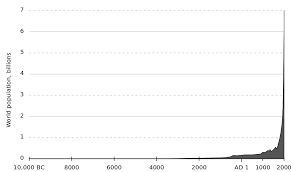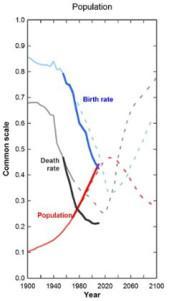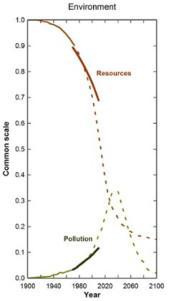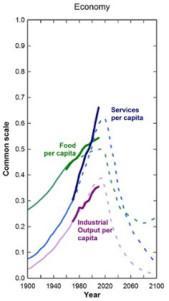Current world population: 7.4+ billion

Recent Human Population Explosion
Ecologists have described numerous examples of boom and bust population cycles in which the explosive growth of a species’ numbers is followed by rapid decline. Compared to the population cycles of other species, the human population’s global extent and impact are remarkable. Our technology has helped us spread across the globe harvesting resources, and changing soil, water, and plant life far more than any other species ever has.
Consequences of Our Population Explosion
Human population impacts take many forms. Here’s an example that may seem insignificant until one considers how often this happens around the world.
Mere Presence Alone

Common Blackhawk
In 2013, a Blackhawk family moved onto Coldwater Farm [LINK]. The hawks built a nest in a tall Cottonwood down by the Agua Fria River that runs through the eastern edge of the Farm. Blackhawks are large black birds with a white band across their tails. They are uncommon and they avoid humans. This year (2016), I watched the fledglings learning to fly. Just like the young Red-tailed hawks at the west end of the farm, the young Blackhawks scream in fear and ecstasy as they make those first great diving swoops. I’m sure the two adults circling above were near collapse with anxiety.
Blackhawks, unlike many other hawk species, will not remain in an area frequented by humans. At Coldwater Farm, we try to discourage would-be river explorers and hikers, but some get in because we can’t watch constantly. So far, the number of trespassers has been small, but this could change. Developers keep trying to alter local zoning restrictions so they can increase housing density around the Farm. So far, we’ve blocked their efforts. If they ever win, the number of people tramping along the river will increase. The same threat extends across the Blackhawk range. With growing population around the world, sensitive wild animals like the Blackhawks are disappearing. When human numbers increase along the river, the Blackhawks will abandon their nest, and since there are few remaining quiet waterways in Arizona, those delightful fledgling flights could end forever.
Regulation of the Human Population
Population growth cycles occur because they produce negative feedbacks that limit numbers. Growing populations consume resources and encourage growth of predator populations. The same kinds of negative feedbacks will limit the human population.
It’s obvious how we reduce available resources by consuming them and by ruining them with our wastes. Less obvious, but still familiar, is the way we enhance our predators. Some plants have the ability to shed chemicals toxic to their herbivore predators. However, if the plants produce the chemicals continuously, their predators can evolve tolerance to the chemicals. Thus, the plants lose their defense and are eaten. Humans enable disease predators by creating and continuously using antibiotics. Like the plants, we enable evolution of tolerance among our disease predators.
There have been numerous analyses of historical collapses of human societies. I like the analysis and predictions of our coming global collapse contained in the 1972 book, Limits to Growth. Scientists recently reanalyzed the book’s research and concurred with the prediction that the first signs of collapse of human civilization will appear in 2020. Here’s a summary of the research.
Limits To Growth Was Right. Research Shows We’re Nearing Collapse
By: Graham Turner and Cathy Alexander (theguardian.com)
“The 1972 book Limits to Growth, which predicted our civilization would probably collapse sometime this century, has been criticised as doomsday fantasy since it was published. Back in 2002, self-styled environmental expert Bjorn Lomborg consigned it to the “dustbin of history”.
“It doesn’t belong there. Research from the University of Melbourne has found the book’s forecasts are accurate, 40 years on. If we continue to track in line with the book’s scenario, expect the early stages of global collapse to start appearing soon.
“Limits to Growth was commissioned by a think tank called the Club of Rome. Researchers working out of the Massachusetts Institute of Technology, including husband-and-wife team Donella and Dennis Meadows, built a computer model to track the world’s economy and environment. Called World3, this computer model was cutting edge.
“The task was very ambitious. The team tracked industrialisation, population, food, use of resources, and pollution. They modelled data up to 1970, then developed a range of scenarios out to 2100, depending on whether humanity took serious action on environmental and resource issues. If that didn’t happen, the model predicted “overshoot and collapse” – in the economy, environment and population – before 2070. This was called the “business-as-usual” scenario.
“The book’s central point, much criticised since, is that “the earth is finite” and the quest for unlimited growth in population, material goods etc would eventually lead to a crash.
“So were they right? We decided to check in with those scenarios after 40 years. Dr Graham Turner gathered data from the UN (its department of economic and social affairs, Unesco, the food and agriculture organisation, and the UN statistics yearbook). He also checked in with the US national oceanic and atmospheric administration, the BP statistical review, and elsewhere. That data was plotted alongside the Limits to Growth scenarios.
“The results show that the world is tracking pretty closely to the Limits to Growth “business-as-usual” scenario. The data doesn’t match up with other scenarios.
“These graphs show real-world data (first from the MIT work, then from our research), plotted in a solid line. The dotted line shows the Limits to Growth “business-as-usual” scenario out to 2100. Up to 2010, the data is strikingly similar to the book’s forecasts. Graphs: Faint and dotted lines, Limits to Growth “business-as-usual projections. Heavy lines, the newly added data.
“As the MIT researchers explained in 1972, under the scenario, growing population and demands for mat

“So far, Limits to Growth checks out with reality. So what happens next?
“According to the book, to feed the continued growth in industrial output there must be ever-increasing use of resources. But resources become more expensive to obtain as they are used up. As more and more capital goes towards resource extraction, industrial output per capita starts to fall – in the book, from about 2015.

“It’s essentially resource constraints that bring about global collapse in the book. However, Limits to Growth does factor in the fallout from increasing pollution, including climate change. The book warned carbon dioxide emissions would have a “climatological effect” via “warming the atmosphere”.
“As the graphs show, the University of Melbourne research has not found proof of collapse as of 2010 (although growth has already stalled in some areas). But in Limits to Growth those effects only start to bite around 2015-2030.

“The issue of peak oil is critical. Many independent researchers conclude that “easy” conventional oil production has already peaked. Even the conservative International Energy Agency has warned about peak oil.
“Peak oil could be the catalyst for global collapse. Some see new fossil fuel sources like shale oil, tar sands and coal seam gas as saviours, but the issue is how fast these resources can be extracted, for how long, and at what cost. If they soak up too much capital to extract the fallout would be widespread.
“Our research does not indicate that collapse of the world economy, environment and population is a certainty. Nor do we claim the future will unfold exactly as the MIT researchers predicted back in 1972. Wars could break out; so could genuine global environmental leadership. Either could dramatically affect the trajectory.
“But our findings should sound an alarm bell. It seems unlikely that the quest for ever-increasing growth can continue unchecked to 2100 without causing serious negative effects – and those effects might come sooner than we think.
“It may be too late to convince the world’s politicians and wealthy elites to chart a different course. So to the rest of us, maybe it’s time to think about how we protect ourselves as we head into an uncertain future.
“As Limits to Growth concluded in 1972: If the present growth trends in world population, industrialisation, pollution, food production, and resource depletion continue unchanged, the limits to growth on this planet will be reached sometime within the next one hundred years. The most probable result will be a rather sudden and uncontrollable decline in both population and industrial capacity.
“So far, there’s little to indicate they got that wrong”.
Will Global Warming Extinguish the Human Species?
The authors of The Limits to Growth did not anticipate the power of global warming. The human population’s resource use and pollution have already had catastrophic effects on Earth ecosystems. Those effects will continue to increase, but by 2100, global warming’s impact will become greater than all the others combined.
Most species survive their boom and bust population cycles. However, the combination of resource exhaustion, antibiotic resistant diseases, pollution, and global warming might do more than reduce our population. It might rub us out.
We’ve Had the Boom. Can We Avoid the Bust?

Other SciFi novels deal with the human impact on the Earth and many are devoted to human experience after a collapse. In the world of applied science, numerous private and public organizations are trying to find reasonable ways to control our population. Here’s one example.
Center for Biological Diversity (CBD) Work on Population
CBD.–“Human population growth and overconsumption are at the root of our most pressing environmental issues, including the species extinction crisis, habitat loss and climate change. To save wildlife and wild places, we use creative media and public outreach to raise awareness about runaway human population growth and unsustainable consumption — and their close link to the endangerment of other species.
“There are more than 7 billion people on the planet, and we’re adding 227,000 more every day. The toll on wildlife is impossible to miss: Species are disappearing 1,000 to 10,000 times faster than the natural rate. It’s clear that these issues need to be addressed before it’s too late.
About Our (CBD) Population and Sustainability Work
“The Center has been working to address the connection between rampant human population growth and the extinction crisis since 2009. Our innovative outreach and public-pressure campaigns — like our award-winning Endangered Species Condoms project — focus on common-sense solutions, including the empowerment of women and girls, the education of all people, universal access to birth control, sustainable consumer choices, and a societal commitment to giving all species a chance to live and thrive.” Continue reading: Population and Sustainability.
Follow this link for a list of other population organizations.
Is Human Extinction Inevitable?
Without global warming, our resource consumption and environmental pollution would have brought about a collapse from which we could recover, smarter and stronger. However, global warming has made recovery uncertain. Glaciers and polar ice caps are melting, sea level is rising, the oceans are warming and becoming acidic, and the weather–heat waves, storms, droughts, and fires–is getting worse. For insightful analyses of these consequences of global warming, go to Robert Fanney’s blog. It’s too late to prevent the coming disasters, but if we could stop population growth, fossil fuel burning, road and building construction, and meat consumption today, we might limit the size of the disasters and insure our species’ survival. Of course, we’re not going to stop today.
Nevertheless, I find it hard to believe that humans will become extinct. Though the coming hardships will exceed the ice ages and anything else we’ve experienced, we are so widely distributed and so adaptable, some of us could survive. We may decline to small bands picking over Earth’s wasted ecosystems, but even the citizens of Mad Max’s dystopian Earth had a future. And so might we.

